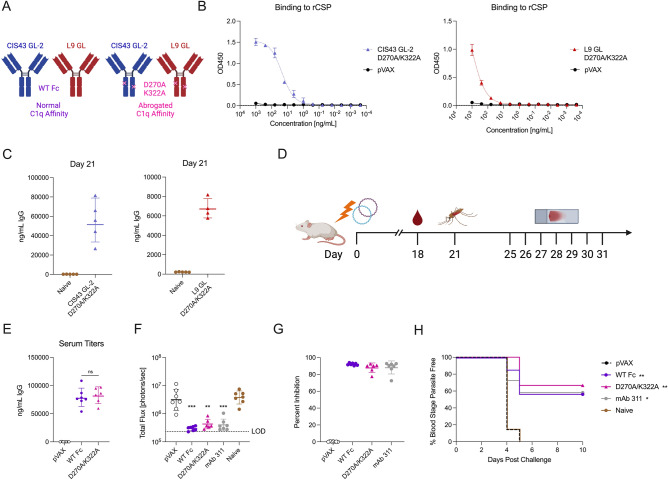Figure 3.
Complement-binding knockout modifications do not impact protection in mosquito bite challenge model. (A) Graphical representation of complement modifications of CIS43 GL-2 and L9 GL. (B) Binding ELISA of pooled supernatants of CIS43 GL-2 constructs (left) and L9 GL constructs (right) harvested from Expi293F transfection to rCSP (mean ± SD). (C) In vivo expression of CIS43 GL-2 D270A/K322A (left) and L9 GL D270A/K322A (right) in BALB/c mice at the peak expression timepoint Day 21. Mice were immunized with 100 µg CIS43 intramuscularly in the tibialis anterior with CD4+/CD8+ T cell depletion (n = 5 mice/group; geometric mean ± geometric SD). (D) Experimental layout of challenge. Mice were immunized with CIS43 GL-2 (50 µg) and L9 GL (100 µg) (abbreviated “WT Fc”) or CIS43 GL-2 D270A/K322A (50 µg) and L9 GL D270A/K322A (100 µg) (abbreviated “D270A/K322A”)and challenged 21 days post administration with mosquitos carrying PbPfLuc parasites. (E) Serum titers of DMAb 18 days post administration. (F) Total flux quantified by IVIS (geometric mean ± geometric SD) (G) Percent inhibition of liver infection relative to infection of naive control infected mice (geometric mean ± geometric SD). (H) Percent of blood stage parasite free mice, determined through blood smears (n = 6–7 mice/group). Statistical analyses were done using a two-tailed Mann–Whitney test between treatment groups (E), with comparisons relative to naïve infected (F,H) or one-way ANOVA adjusted for multiple comparisons between all treatment groups (G). **p < 0.01, ***p < 0.001.

